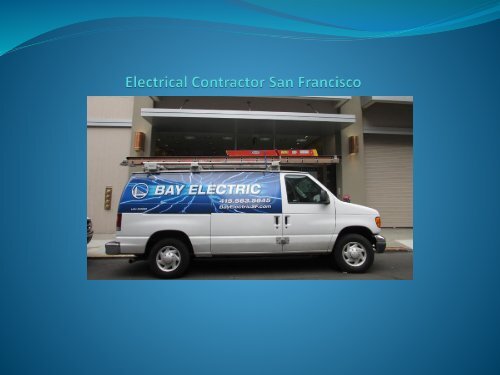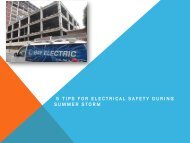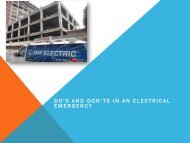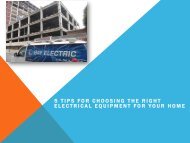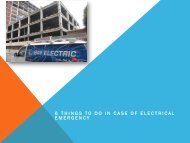Electrical-Contractor-SanFrancisco
You also want an ePaper? Increase the reach of your titles
YUMPU automatically turns print PDFs into web optimized ePapers that Google loves.
Ten Safety Rules for Working with <strong>Electrical</strong> Equipment<br />
According to the statistics by National Institute of Health of the United States, around 1000 persons die of<br />
electrocution or electric hazards every year. The OSHA’s electrical safety manual includes the list of fatal<br />
electrical accidents and the reasons behind UAW-electrical fatalities. The reasons vary from improper<br />
grounding of electrical equipment to energy not disconnected properly before and during the work.<br />
Only in few cases, the reason for electrocution or electricity accident can be stored electrical energy or<br />
other major circuit issues. But, most of the times the electrocution happens because of lack of safety<br />
practices regarding safety gears and safety precautions. As an <strong>Electrical</strong> <strong>Contractor</strong> San Francisco with past<br />
30 years’ experience in working with both high and low voltage electrical equipment, I have prepared this<br />
safety guideline for the electricians and DIY electrical workers. Following simple safety rules can save you<br />
from serious electrical injuries including death, seizures, spinal cord damage, burns, and never damages.
Always Wear Safety Gear:<br />
You will be working with live electricity and electrical equipment, so wearing a safety gear does not have<br />
any exception. Especially in the tasks which involve working with high voltage circuits, you should wear<br />
non-conducting gloves and shoes. The materials such as rubber and wood are non-conductive and break<br />
the electricity circuit.<br />
Never Touch an Energized Circuit:<br />
If you are working with energized circuit, it means you are calling for trouble. So, always switch off the<br />
circuits and electrical board before commencing the work. Disconnecting the circuit reduces the risk up to<br />
95%.
Avoid Wearing Metallic Accessories:<br />
For the DIY individuals, it is easy to forget this rule. If you are wearing a metallic band, a wrist watch, a ring<br />
or any other accessory, it is always safe to take them off before working with electrical equipment.<br />
Avoid Contact with Water or Other Conductive Liquids:<br />
I believe that it is common sense, but it is good to reiterate it. Always keep your hands dry when you are<br />
working with electrical equipment and avoid contact with water with the electrical circuit. If water or any<br />
other liquid is spilled on the electrical circuit, switch off the circuit and dry it before resuming the work.<br />
De-Energize Circuits in Wet Areas:<br />
For the love of swimming pools of Bay Area Residents, the Electricians San Francisco have to work on<br />
swimming pool lights and other areas with the wet atmosphere. It is always good to start the job with a<br />
preliminary investigation of the working environment to know the underground electric wires and their<br />
condition.
Insert the right plug in the right socket:<br />
If a plug has three-prongs, always insert it in the three-slot socket. Do not try to cut down or break the<br />
prongs to insert them in appropriate circuit as it may cause short circuit.<br />
Follow the <strong>Electrical</strong> Codes:<br />
Every area has different electrical codes and voltage instructions. When you are working with large projects<br />
such as wiring of a building or circuit breakers, you should ensure compliance to electrical codes.<br />
Watch out for Sparks:<br />
If an electric circuit or equipment is making sparks, it means that the circuit needs to be changed or<br />
repaired.<br />
Always Check Grounding of Electricity:<br />
The electricity flows to the ground and grounding ensures safe electric flow without any risk of electric<br />
shock.<br />
Never Leave an Energized Circuit Unattended:<br />
Whether you are working with an electrical board or an equipment, never leave an energized circuit<br />
unattended. Even if you are going for few seconds, always de-energize the circuit.
Contact:<br />
Kevin Valerio<br />
1288 Columbus Ave. #164<br />
San Francisco, CA 94133<br />
415-563-5645<br />
http://www.bayelectricsf.com


